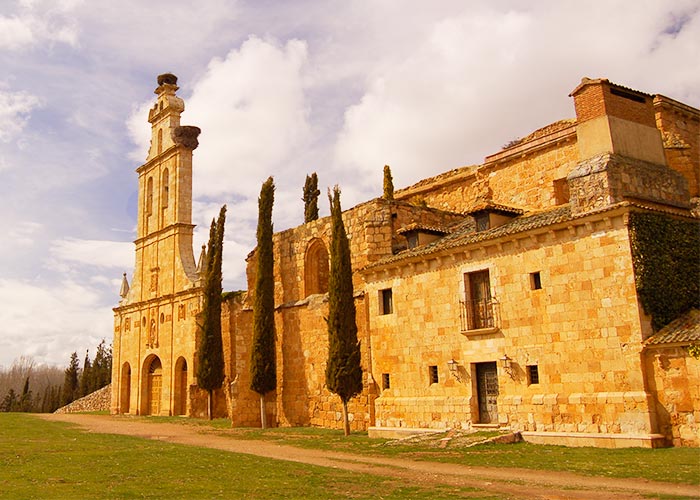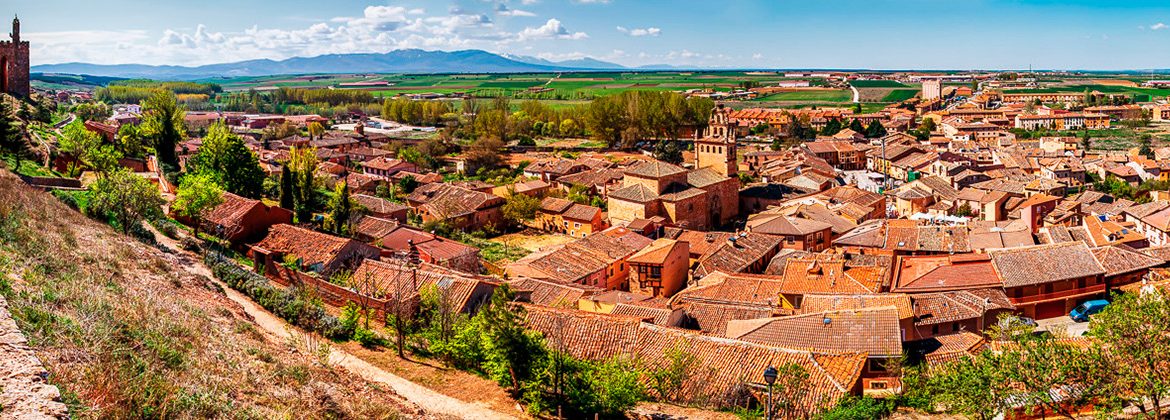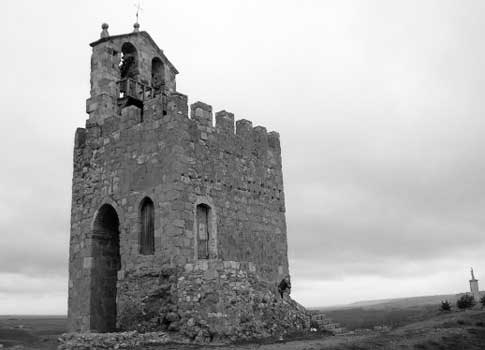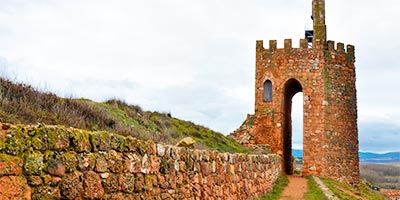Bridges, arches and palaces
The visit to what there is to see in Ayllon usually starts from the road that comes from Madrid and Segovia. The Puente de la Villa over the Aguisejo River was built by the Comunidad de Villa y Tierra in 1661. It was rebuilt in 1782 under Charles III.
On entering the village you will find El Arco, which gives access to the old walled enclosure. Immediately you will find the Contreras Palace. It can be recognized by the mark of the Franciscan cordon and the coats of arms of the stone doorway built in 1497 by Don Juan de Contreras, Lord of Ayllon.
The building had previously belonged to the Constable Don Alvaro de Luna. Inside it preserves coffered ceilings from the first period and it is a national monument.
Pellejeros Street which turns left takes us to the Bishop Vellosillo Palace in the square which bears his name. It was built at the end of the 16th century. Another of the infrastructures to see in Ayllon.
This artistic monument now houses the Tourist Office and a Museum of Contemporary Art. It has more than 250 works by painters from the San Fernando School of Fine Arts (such as Genovés, Bárjola, Lucio Muñoz..), who came to paint there. It also includes an artistic restoration workshop.
Main buildings
From Pozo Street you can access the Casa de la Torre. It is currently the office and social centre of Caja Segovia. From the beginning of the 16th century it belonged to the Cabildo, and then passed into the hands of several noble families.
The Town Hall House, at the head of the Plaza Mayor, was the residence of the first Marquises of Villena, whose coats of arms still remain on its façade. The building was a palace at the beginning of the 16th century. Its façade was modified in 1622 and adapted in 1640 for administrative services and a meeting room. In 1756 the clock was placed.
The French troops between 1808 and 1809 occupied the building, leaving it in ruins. The original polychrome wood coffered ceiling and its archive were lost in 1945, due to a fire.
The Town Hall is flanked by the Church of San Miguel and the so-called Casa de Eugenia de Montijo. The church of San Miguel was the last parish to be grouped together in the Plaza Mayor in 1902.
It is worth seeing its belfry, doorway and Romanesque apses in Ayllon. The doorway has an arch with rosettes, zigzags and chess pieces. The door was brought from the chapel of San Sebastian in the Church of San Juan.
Among the things to see in Ayllon, the apse is interesting, with foliated capitals and corbels, as well as the central window in a loophole. As a curiosity, in 1675 the Town Council agreed to build a wooden lookout point in it to attend the bullfighting celebrations. A recent restoration has eliminated it.
The Casa Palacio de la Emperatriz Eugenia de Montijo belonged in 1693 to the Vellosillo family. It was called “House of the Maidens”.
In the middle of the 19th century it belonged to Doña María Francisca de Sales, Portocarrero, the elder sister of the Empress Eugenia de Montijo. On its cover is the heraldic coat of arms of the Empress of France, as it was there that she rested on the journeys between Paris and Madrid.
Santa María la Mayor
Behind the Town Hall, on the Plaza Ángel de Alcázar is Santa María la Mayor, the oldest parish to be seen in Ayllon. It was built on the site of the synagogue closed by San Vicente Ferrer in 1411. It also has elements of a previous Romanesque building.
The work to build Santa Maria la Mayor began in 1613 and ended with the belfry in 1724. On the outside you can admire the chrismon and sculptures from other temples.
The current main altarpiece was acquired in 1840 from the owners of a convent to replace the previous altarpiece, which was burned by the French in 1808. It includes the image of the Virgin of the Steppe, which is venerated as the patron saint. There is also an altar dedicated to the Santo Cristo de Santiago.
There are other houses and palaces to see in Ayllon which give an idea of its splendour (Casa de la Sal, Casas de San Juan, Casas de las Beatas de Lara, Casas de Villazán) in the streets Real and El Parral, and around the Plaza Ángel de Alcázar.
Through El Parral Street you can reach the Convent of the Concepción Franciscana, founded in 1528 by Don Diego López Pacheco. Its coat of arms is on the cover.

Convent of Concepción Franciscana
An important Romanesque Church
In addition to what you can see in Ayllon, in the Calle Real there is also the Casa del Aguila. It was built in 1615 and includes a coat of arms of the Guzman, Robles, Cabrera and Maldonado families. Continuing to Dr. Tapia Street and San Juan Street we arrive at the Romanesque Church of San Juan. Its tower was part of the wall and is an interesting point to see in Ayllon.
Of private property, it has a gothic chapel dedicated to San Sebastian and a triumphal arch. This gives access to the main chapel with the burials of the Nuñez and Daza families. In 1621 a fridge was built behind it. Its ice was sold during the summer months.
Towers and castles
Leaving the church, along the Travesía Mediavilla we arrive at the Calle del Castillo. Through it we go up to the Martina Tower. This is what remains to be seen in Ayllon of the primitive church of San Martin, in turn built on top of the old castle, destroyed in 1295. This tower preserves Celtiberian remains.
Through the Paseo de las Bodegas we reach the Arab wall Los Paredones. The Castle was on a hill surrounded by a tapial called “Los Paredones” with perpendicular beams embedded in the walls and boards resting on them.
In the filling with earth you can find ancient vessels. The walls were rebuilt from 1420 by Don Alvaro de Luna. They had three gates: “El Arco”, “La Puerta de Languilla” and the “Puerta de San Juan” or “Santa Lucía”. The last two were demolished in 1876 to allow the entrance of carriages.
Outside the town centre, in the direction of Aranda de Duero, is the Old Cemetery. Its Romanesque façade belonged to the Romanesque Hospital del Sancti Spiritu. Nowadays it is a nursing home.
A tourist offer of special relevance in Ayllon is its dramatized guided tours on historical aspects of the town from the 13th to the 16th century. Characters like Don Alvaro de Luna, San Vicente Ferrer or Catalina Lancaster. And also scenes of daily life dramatized all of them by actors during almost two hours.





